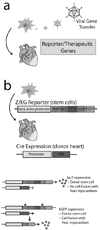Aesthetic cardiology: adipose-derived stem cells for myocardial repair
- PMID: 19941452
- PMCID: PMC2896012
- DOI: 10.2174/157488810791268654
Aesthetic cardiology: adipose-derived stem cells for myocardial repair
Abstract
Stem cell biology has increasingly gained scientific and public interest in recent years. In particular, the use of stem cells for treatment of heart disease has been strongly pursued within the scientific and medical communities. Significant effort has gone into the use of adult tissue-derived stem cells for cardiac repair including bone marrow, blood, and cardiac-derived cell populations. Significant interest in this area has been balanced by the difficulties of understanding stem cells, cardiac injury, and the amalgamation of these areas of investigation in translational medicine. Recent studies have emerged on adipose-derived stem cells which show the potential for cardiac lineage development in vitro and may have application in cell-mediated in vivo therapy for the diseased heart. This review provides a summary of current findings within the field of adipose-derived stem cell biology regarding their cardiac differentiation potential.
Figures



Similar articles
-
Neural differentiation and therapeutic potential of adipose tissue derived stem cells.Curr Stem Cell Res Ther. 2010 Jun;5(2):153-60. doi: 10.2174/157488810791268645. Curr Stem Cell Res Ther. 2010. PMID: 19941451 Review.
-
Maturation status of sarcomere structure and function in human iPSC-derived cardiac myocytes.Biochim Biophys Acta. 2016 Jul;1863(7 Pt B):1829-38. doi: 10.1016/j.bbamcr.2015.11.005. Epub 2015 Nov 11. Biochim Biophys Acta. 2016. PMID: 26578113 Free PMC article. Review.
-
Cartilage regeneration using adipose-derived stem cells.Curr Stem Cell Res Ther. 2010 Jun;5(2):129-32. doi: 10.2174/157488810791268627. Curr Stem Cell Res Ther. 2010. PMID: 19941456 Review.
-
Periodontal disease and periodontal tissue regeneration.Curr Stem Cell Res Ther. 2010 Jun;5(2):168-74. doi: 10.2174/157488810791268672. Curr Stem Cell Res Ther. 2010. PMID: 19941449 Review.
-
The potential for treatment of skeletal muscle disorders with adipose-derived stem cells.Curr Stem Cell Res Ther. 2010 Jun;5(2):133-6. doi: 10.2174/157488810791268573. Curr Stem Cell Res Ther. 2010. PMID: 19941455 Review.
Cited by
-
Biomaterial Approaches for Stem Cell-Based Myocardial Tissue Engineering.Biomark Insights. 2015 Jun 1;10(Suppl 1):77-90. doi: 10.4137/BMI.S20313. eCollection 2015. Biomark Insights. 2015. PMID: 26052226 Free PMC article. Review.
-
Regression modeling to inform cell incorporation into therapies for craniosynostosis.J Craniofac Surg. 2013 Jan;24(1):226-31. doi: 10.1097/SCS.0b013e31826cfe09. J Craniofac Surg. 2013. PMID: 23348290 Free PMC article.
-
Fabrication of nanofiber scaffolds with gradations in fiber organization and their potential applications.Macromol Biosci. 2012 Oct;12(10):1336-41. doi: 10.1002/mabi.201200115. Epub 2012 Jul 30. Macromol Biosci. 2012. PMID: 22847852 Free PMC article.
-
PERIPHERAL NERVE REGENERATION: CELL THERAPY AND NEUROTROPHIC FACTORS.Rev Bras Ortop. 2015 Nov 16;46(6):643-9. doi: 10.1016/S2255-4971(15)30319-0. eCollection 2011 Nov-Dec. Rev Bras Ortop. 2015. PMID: 27027067 Free PMC article. Review.
-
Adipose tissue-derived stem cells show considerable promise for regenerative medicine applications.Cell Mol Biol Lett. 2013 Dec;18(4):479-93. doi: 10.2478/s11658-013-0101-4. Epub 2013 Aug 14. Cell Mol Biol Lett. 2013. PMID: 23949841 Free PMC article. Review.
References
-
- Housman TS, Lawrence N, Mellen BG, et al. The safety of liposuction: results of a national survey. Dermatol Surg. 2002;28:971–978. - PubMed
-
- Zuk PA, Zhu M, Mizuno H, et al. Multilineage cells from human adipose tissue: Implications for cell-based therapies. Tissue Eng. 2001;7:211–228. - PubMed
-
- Psaltis PJ, Zannettino AC, Worthley SG, Gronthos S. Concise review: mesenchymal stromal cells: potential for cardiovascular repair. Stem Cells. 2008;26:2201–2210. - PubMed
-
- Strem BM, Hicok KC, Zhu M, et al. Multipotential differentiation of adipose tissue-derived stem cells. Keio J Med. 2005;54:132–141. - PubMed
-
- Safford KA, Rice HE. Stem cell therapy for neurologic disorders: Therapeutic potential of adipose-derived stem cells. Curr Drug Targets. 2005;6:57–62. - PubMed
Publication types
MeSH terms
Grants and funding
LinkOut - more resources
Full Text Sources
Other Literature Sources
Medical

